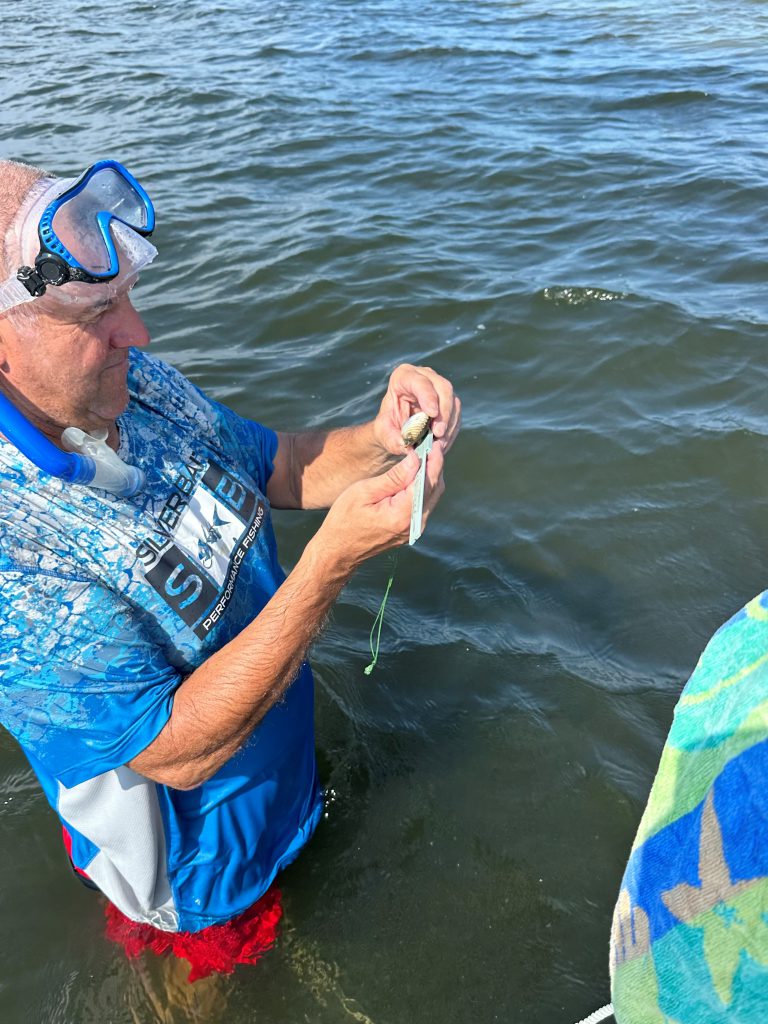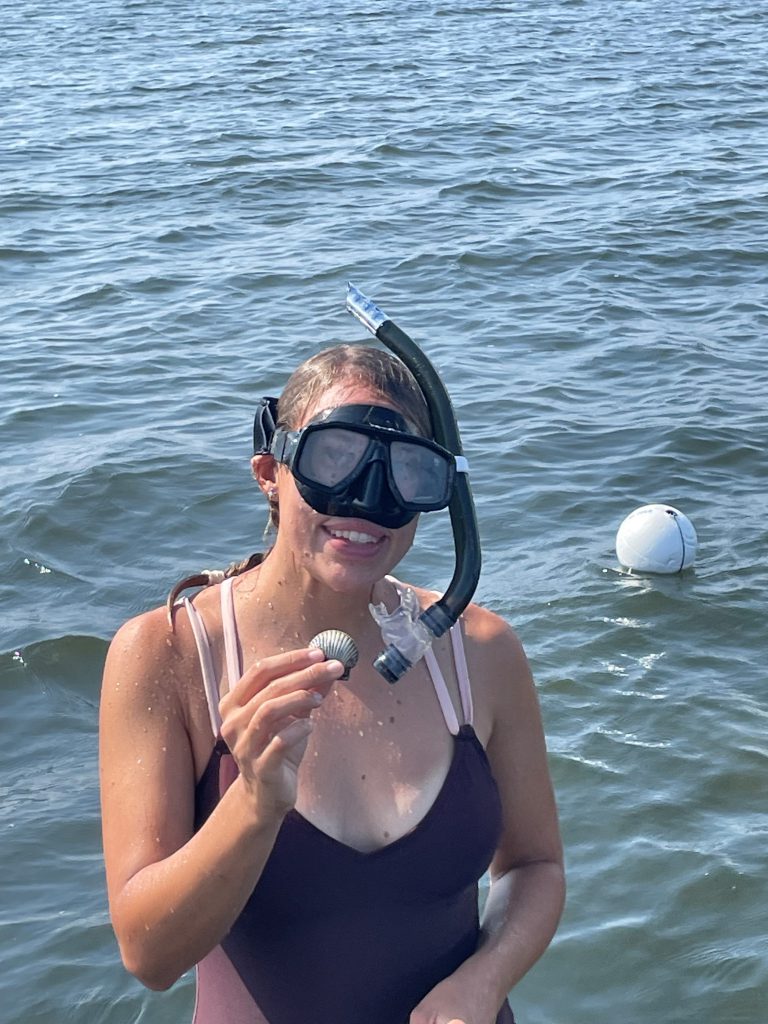Introduction
Bay scallops (Argopecten irradians) have been an important part of the economy of many gulf coast communities within the Florida Big Bend for decades. It was once abundant in all gulf coast counties of the state but beginning in the 1960s populations in many bays began to decline to levels where they are all but nonexistent. The cause of this decline has been associated with many factors including a decline in water quality, a decline in suitable habitat (sea turtle grass beds – Thalassia), and overharvesting. Most likely the cause included all of these. Since the collapse of both the commercial and recreational fishery, Gulf coast communities have been trying to address all three of the stressors above. Multiple monitoring projects are ongoing in the Pensacola Bay area and one of those is the Great Scallop Search.
The Great Scallop Search was developed by Sea Grant Agents in Southwest Florida and expanded, through Florida Sea Grant, to Northwest Florida. In each location volunteers snorkel a 50-meter transect line searching for live bay scallops, as well as monitoring the status of the seagrass habitat. Since 2015 317 volunteers have logged 634 hours surveying 407 50-meter transects in 106 grids in Big Lagoon or Santa Rosa Sound. In that time 4 live scallops have been logged, though we hear anecdotal reports of additional scallops being found in these bodies of water.
Survey Method
Volunteers select and survey one of 11 grids in Big Lagoon, or one of 55 grids in Santa Rosa Sound. Once on site, the volunteers anchor and record preliminary information on the data sheet provided. Two snorkelers enter the water and swim on opposite sides of a 50-meter transect line searching for live scallops. Any live scallop found is measured and returned. The species and density of the seagrass is recorded as well as the presence/absence of macroalgae on that seagrass. Four such transects are surveyed in each grid.
2023 Results
| 2023 | SRS | BL | Total | Other |
| # of volunteers | 72 | No significant difference between 2022 and 2023 | ||
| # of grids surveyed | 8 | 8 | 16 | Slight decrease from 2022. 16 of the 66 grids (24%) were surveyed. |
| # of transects surveyed | 26 | 51 | 77 | A decrease from 2022. More surveys were conducted in Big Lagoon than Santa Rosa Sound. |
| Area surveyed (m2) | 2600 | 5100 | 7700 | 1.9 acres |
| # of scallop found | 2 | 2 | 4 | Four live scallops are a record for this project. It equals the sum of all other live scallops since the project began. |
| Scallop Size (cm) | 4.5, 5.0 | 4.0, 4.5 | ||
| Surveys with Seagrass | ||||
| Halodule | 5 | 12 | 17 | 17/21 surveys – 81% |
| Thalassia | 8 | 11 | 19 | 19/21 surveys – 90% |
| Syringodium | 0 | 2 | 2 | 2/21 surveys – 10% |
| Grass Density | ||||
| 100% grass | 3 | 9 | 12 | 12/21 surveys (57%) were 100% grass |
| 90% | 1 | 0 | 1 | Note: Volunteers typically select area for transects |
| 75% | 3 | 1 | 4 | with a lot of grass. |
| 70% | 1 | 0 | 1 | |
| 50% | 3 | 9 | 12 | |
| 5% | 1 | 0 | 1 | |
| Macroalgae | ||||
| Present | 4 | 4 | 8 | |
| Absent | 2 | 10 | 12 | 12/21 surveys (57%) had no macroalgae. |
| Abundant | 2 | 2 | 4 | |
| Sediment Type | ||||
| Mud | 0 | 1 | 1 | |
| Sand | 7 | 8 | 15 | 15/21 surveys (71%) were sandy. |
| Mixed | 1 | 4 | 5 |
21 surveys were conducted covering 16 grids. 8 grids were surveyed in each body of water.
A total of 77 transects were conducted covering 7,700 m2 and four live scallops were found.
Two of the scallops were found in Big Lagoon and two in Santa Rosa Sound.
All scallops measured between 4-5cm (1.6-2”).
The number of live scallops found this year equaled the total number found over the last eight years.
Most of the transects included a mix of Halodule and Thalassia seagrass ranging from 100% coverage to 5%. The majority of the transects were between 50-100% grass. Four transects had 100% Thalassia. Three of those were in Santa Rosa Sound, one was in Big Lagoon. The diving depth of the volunteers ranged from 0 meters (0 feet) to 2.4 meters (8 feet). Macroalgae was present in 8 of the 21 surveys (38%) but was not abundant in most.

Summary of Project
| Year | Volunteer | Grids Surveyed | Transects Surveyed | Live Scallops Found |
| 2015 | 87 | 28 | 101 | 0 |
| 2016 | 96 | 31 | 111 | 1 |
| 2017 | 5 | 4 | 16 | 0 |
| 2018 | 20 | 7 | 32 | 0 |
| 2019 | 13 | 6 | 20 | 0 |
| 2020 | 5 | 2 | 16 | 1 |
| 2021 | 17 | 6 | 24 | 0 |
| 2022 | 74 | 22 | 87 | 2 |
| 2023 | 72 | 16 | 77 | 4 |
| TOTAL | 317 | 407 | 8 | |
| MEAN | 35 | 14 | 45 | 0.4 |
To date we are averaging 35 volunteers each event, surveying 14 of the 55 possible grids (25%). We are averaging 45 transects each year (4500 m2), have logged 407 transects (40,700 m2) and have recorded 8 live scallops (< than one a year).
Discussion
Based on the results since 2016 this year was a record year for live scallops. Whether they are coming back on their own is still to be seen. Being mass spawners, bay scallop need high densities in order to reproduce successfully, and these numbers do not support that. The data, and comments from volunteers, suggest that the grasses look good and dense. Thalassia, a favorite of the bay scallop, appear to be becoming more abundant. This is a good sign.

- Rattlesnakes on Our Barrier Islands; Part 4 – Thermoregulation - December 29, 2025
- Rattlesnakes on Our Barrier Islands; Part 3 – Envenomation - December 22, 2025
- St. Joe Red Tide Claiming Terrapins - December 15, 2025
